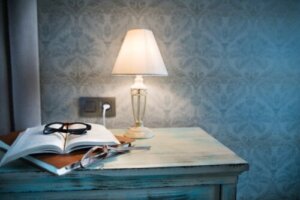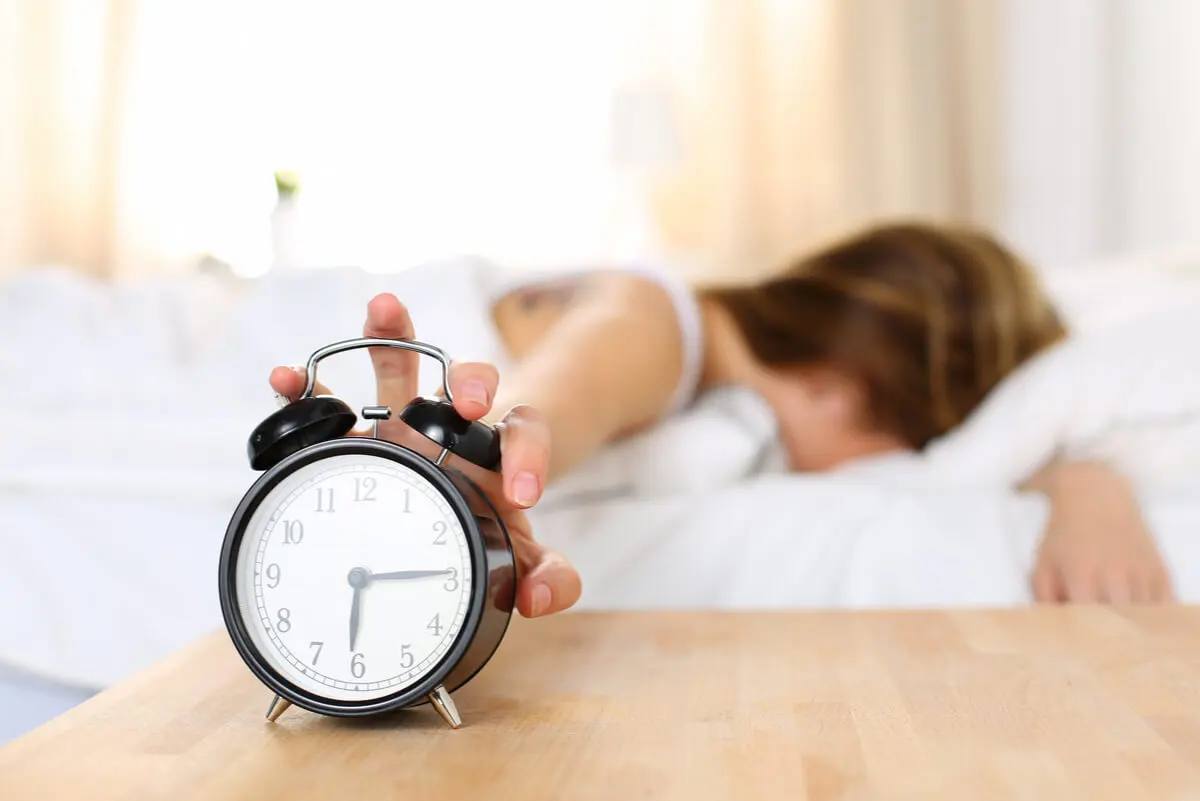10 Things You Should Have on Your Nightstand

Nightstands are a star element in the bedroom because they’re functional and add to the decor. It’s difficult to imagine a bedroom without them. In this article, we’ll tell you about the things you should have on your nightstand table so that you’re always comfortable and prepared.
The bedroom is a place where you should feel comfortable and at ease because it’s the space intended for sleep, rest, and comfort. Therefore, it should have a very defined personal touch, even more than other places in the house.
Reasons to have a nightstand
Can you imagine being comfortable in bed, about to sleep, and having to get up to turn off the light, get a glass of water, or put away objects such as your cell phone or your glasses on the floor? For this not to happen, nightstands are great allies. Their main advantage is that they’re very practical and make life more comfortable.
Nightstands allow you to store personal items to have them at hand and store them neatly in drawers. As for decoration, they often match the bed and other furniture and add a nice touch.
They come in different shapes and colors. There are even some that come with the bed. In addition, they can hold other types of objects, such as picture frames, lamps, flowers, or decorative reminders.

Things you should have on your nightstand
A nightstand is very useful because it allows you to have at hand personal items that are required in the room or before bedtime. However, it can become a place to accumulate clutter and unnecessary things.
Therefore, it’s important that you do a cleaning and leave there what really brings benefits to the decoration of your room or your sleeping routine.
Let’s take a look at some things you may want to have on your nightstand.
We think you may also enjoy reading this article: 5 Ideas for a More Welcoming and Relaxing Bedroom
1. A lamp
Having a lamp on the nightstand is a must, because if anything happens, it’s very useful to have a light source at hand. It also allows you to read before going to sleep or to illuminate the room at night in a dimmer way than with the bulbs on the ceiling. Similarly, a good lamp is also a decorative element that adds a lot of style to a room.
2. A book or hobby
Reading at night brings many benefits. Reading is a habit that exercises the mind, entertains, and provides knowledge. In the case of children, reading is also an excellent way to help them fall asleep and to associate the moment with a positive activity.
If you like to read, you can’t miss a good book on your bedside table. However, try not to accumulate them in excess, as this will generate clutter.
If, on the other hand, you do not like to read traditional books, you can keep your tablet on the nightstand. However, other hobbies are welcome, such as a Rubik’s cube, a sketchbook, or a candle for meditation.
3. Comforting things
Among the things you should have on your nightstand, certain elements that provide comfort and are part of your rest and sleep routine should not be missing.
For instance, you can keep some essential oils that help you relax, a moisturizer to sleep, a face massager, or a sleep mask.
4. Medication
It’s also essential to have certain basic medications nearly, such as medications for headaches, heartburn, or stomach discomfort.
Nightstands are also the ideal place to store medication that you have prescribed for daily use, especially if you have to take them when you wake up or at bedtime. You can also store birth control pills or condoms there.
5. A thermometer
When a person feels ill or is sick, it’s very common for them to rest and lie down in bed. A fever is a warning sign for many respiratory diseases and infections.
Therefore, if you feel sick in bed and feel a rise in temperature, it’s important to have a thermometer handy to monitor if you are having an episode of fever.
On the other hand, due to the side effects of hormonal contraceptives, non-hormonal contraceptive methods that recognize fertility through biomarkers are becoming more and more popular. One of the signs to identify fertile days is an increase in temperature, which is another good reason to have a thermometer close by.
6. Decorative objects
The “Practical Guide to Interior Design and Decoration” points out that, as a general rule, bedroom decoration should not be too over the top or garish, especially in adult bedrooms. Although the bedroom is no longer a place that is limited only to sleep since it’s often used for work, leisure, and other activities, it should be functional.
Therefore, a perfect decorative object for the bedside table can be a family photograph. Also, you can use only a lamp that, in addition to illuminating, is aesthetically pleasing.
Like this article? You may also like to read: Open Concept: The Decorative Style You’ll Want to Know About
7. A jewelry box
At night, it’s common to remove your jewelry to have a good rest. However, these small objects are easily lost.
Therefore, it’s a good idea to have a jewelry box on your nightstand that allows you to deposit earrings, rings, your watch, or even piercings. This way, it will be easy to keep them in order and find them the next morning.
8. A cup holder
Many people like to drink water at night to stay hydrated and avoid thirst when sleeping. Also, there are drinks that help to have a better rest and it’s recommended to take them to fall asleep quickly.
Consequently, it’s a good idea to have a cup holder on the bedside table to rest the hot cups or glasses with water and thus prevent them from spilling and damaging the wood of the bedside table.
9. A remote control
Although feng shui does not recommend having electronic devices in the bedroom, it is still common to find televisions in bedrooms. In this regard, it’s very useful to reserve space for the remote control on the bedside table. This way, it won’t get lost and will always be at hand to turn off the TV before going to sleep.
10. Useful accessories

Without a doubt, the things you should have on your nightstand should make your life easier. This is a very personal storage space that should be exclusively for you.
Therefore, you can keep useful accessories there, such as hair ties, mirrors, an agenda, a cell phone charger, a glasses case, and an alarm clock, if you use one.
Avoid elements that keep you from sleeping
The National Institute of Neurological Disorders and Stroke points out that, to get a good night’s sleep, it’s necessary to avoid exposure to loud noises or lights and reduce the use of the TV and computer in bed. Therefore, it’s recommended that you keep these types of elements away from your bedside table.
Also, avoid putting flowers that emit unpleasant odors or leaving food that can spoil. On the other hand, it’s important that you don’t let dirt, dust, and clutter accumulate on your nightstand. If, for example, you empty your pockets near your bedside table before putting on your pajamas, don’t leave any trash receipts, papers, or loose change on this important piece of furniture.
All cited sources were thoroughly reviewed by our team to ensure their quality, reliability, currency, and validity. The bibliography of this article was considered reliable and of academic or scientific accuracy.
- Can electronics affect quality sleep? (2017, July 27). Retrieved April 13, 2021, from Sleepfoundation.org website: https://www.sleepfoundation.org/how-sleep-works/how-electronics-affect-sleep
- P. Frank-Herrmann, J. Heil, C. Gnoth, E. Toledo, S. Baur, C. Pyper, E. Jenetzky, T. Strowitzki, G. Freundl, The effectiveness of a fertility awareness based method to avoid pregnancy in relation to a couple’s sexual behaviour during the fertile time: a prospective longitudinal study, Human Reproduction, Volume 22, Issue 5, May 2007, Pages 1310–1319, https://doi.org/10.1093/humrep/dem003
- Madrigal Gramaje J. Guía práctica de interiorismo y decoración. 1st ed. Valencia: Obrapropia; 2012 Recuperado de: http://www.obrapropia.com/ebooks.ashx?sid=OTU0JjYzNDg0MTYzMzM0NzM0NjI1MA==
- National Institute of Neurological Disorders and Stroke. (2019, August 13). Brain Basics: Understanding Sleep. Retrieved October 26, 2020, fromhttps://www.ninds.nih.gov/Disorders/Patient-Caregiver-Education/Understanding-Sleep
This text is provided for informational purposes only and does not replace consultation with a professional. If in doubt, consult your specialist.








